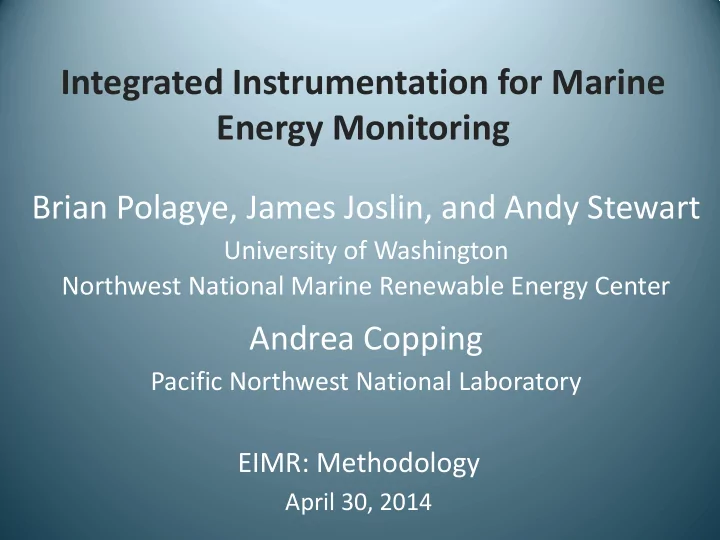

Integrated Instrumentation for Marine Energy Monitoring Brian Polagye, James Joslin, and Andy Stewart University of Washington Northwest National Marine Renewable Energy Center Andrea Copping Pacific Northwest National Laboratory EIMR: Methodology April 30, 2014
Motivation: Environmental Risk Uncertainty Significant Uncertain Risk Discountable Risks Mitigate Risk Monitor Strategic Research Investment Identified Risks “Retired” Risks Residual Uncertainty
Reducing Risk Uncertainty Severe outcomes are likely to rarely occur Observing interactions may require spatially comprehensive and temporally continuous monitoring Strategy likely to generate “data mortgages” Stereo-optical 3 months 600 TB of X = Cameras (2 Mpx X 80 MB/s observations storage @ 10 fps) Example : Continuous stereo-optical monitoring for a single camera pair. Comprehensive monitoring would require multiple pairs.
Integrated Instrumentation Packages Low-cost and near-term approaches to improve ratio of information gained to data archived Multi-beam Sonar Passive Acoustic Tracking capability at Detection ranges out to 100 m Omni-directional Processing in near coverage at ranges on real-time the order of 1 km Processing in near MEC real-time Optical Camera Short range and Example : Detection, tracking, and identification of a marine limited field of view mammal approaching a MEC Requires archival processing
Constraints for Integrated Packages Data and Power Cabled MEC Export Package Bandwidth Cable Close Coupling and to MEC “Plug & Maintainable Recoverable Socket” and Adaptable Package Approach
Adaptable Monitoring Package (AMP) “Plug” “Socket”
AMP Infrastructure and Instrumentation Power and data infrastructure Securement and recovery system Instruments
AMP Integration: Tidal Energy AMP OpenHydro Open Centre turbine (6 m diameter)
Recovery/Deployment Options Converter Divers Recovery Short work windows Can be expensive and risky Human safety risk Subsea ROV Winch Servicing Moving parts in the ocean Short work windows Winch failure can cause catastrophic system failure
AMP Operations Concept: Tidal Energy Umbilical AMP and Deployment ROV Launch Platform Current Direction
“Millennium” Falcon Deployment System SAAB SeaEye Falcon Inspection-class “Millennium” Skid ROV 6 Thrusters 4 Vectored 4 Vectored Thrusters 2 Vertical Docking alignment Securement actuators Power and comms (SeaView)
System Stability Center of Thrust and Center of Pressure – Vertical alignment to prevent pitching – Horizontal alignment may require adjustment, Center of pending field trials Thrust Center of Pressure
Summary Integrated instrumentation packages will play a critical role in reducing environmental risk without incurring large data mortgages Package design requires a significant systems engineering effort
Acknowledgements This material is based upon work supported by the Department of Energy under FG36-08GO18179-M001 and Snohomish Public Utility District. The AMP represents the engineering efforts of the authors, as well as a broader team including Paul Gibbs (APL), Chris Siani (APL), Trina Lichtendorf (APL), Tom Jackson (Jackson Engineering), and Danny Miles (Snohomish PUD).
Recommend
More recommend